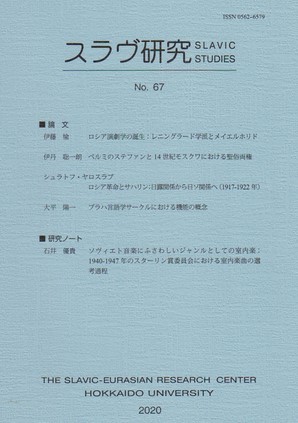現代ベラルーシ語の標準語規範の分裂と対立
Divergence and Conflict between the Two Norms of the Modern Belarusian Literary Language
Author(s): Shiori KiyosawaSubject(s): Lexis, Historical Linguistics, Sociolinguistics, Belarussian Literature, Eastern Slavic Languages, Interwar Period (1920 - 1939)
Published by: Slavic Research Center
Keywords: Divergence and conflict; Modern Belarusian literary language; Taraškievica; Belarusian dictionaries; development of orthography;
Summary/Abstract: The problem of divergence and conflicts between literary norms is considered a particularly significant problem that arose during the formation of the modern Belarusian literary language. Practically, there are two types of literary Belarusian used in today’s Belarusian society. One is the official literary norm formed during the Soviet era (after 1933, to be precise) and used for many years in administration, education, and publication inside Belarus. The other is the literary norm Taraškievica, which was supported by some Belarusians, including intellectuals, from the Perestroika period. Taraškievica is a literary norm of modern Belarusian that was originally popularized in the 1920s and is named for the linguist Branislaŭ Taraškievič, the author of “Belarusian Grammar for Schools” (Vilnius, 1918), which was the foundation for the norm. These two literary norms are currently at odds in Belarusian society over which is the “authentic” Belarusian literary language. This article explores how divergence and conflicts between two Belarusian literary norms have emerged and how the two linguistic norms are regarded as “authentic” by their supporters. First, I overview the history of modern literary Belarusian from the perspective of corpus planning in language policy. Second, I analyze linguistic ideologies among the proponents of official norms and Taraškievica by focusing on the meta-linguistic discourse of the supporters of two standard language norms. Although Belarusian was exclusively used as a spoken language by peasants or poor szlachtas at the end of the eighteenth century, it began to be used for literary works starting in the nineteenth century. At the same time, linguistic research on the Belarusian language (to be precise, Belarusian dialects of Russian) was also promoted in the Russian Empire. In 1905 the tsarist government for the first time officially permitted publishing activity in Belarusian. After the collapse of the tsarist regime, with “Belarusian Grammar for Schools” published by B. Taraškievič in 1918, the orthographic and grammatical norms presented in this book were widely endorsed by the Belarusian intellectuals of that time and quickly brought into everyday linguistic practice. After the establishment of the Byelorussian Soviet Socialist Republic (BSSR) in 1919, it was the Soviet government, rather than individuals such as writers, linguists, and social activists, that guided the formation of the Belarusian literary language. Within the BSSR, the Institute of Belarusian Culture (later the Belarusian Academy of Sciences) played a leading role in the compilation of scientific terminology and Belarusian dictionaries, development of orthography, and other projects. When the Stalinist regime began in the 1930s, however, the linguists of the Academy of Sciences, who had led the standardization of Belarusian, were successively purged. In 1933, the BSSR’s Council of People’s Commissars implemented the orthographic reform that rendered the Belarusian orthographic norms, and some grammatical norms, closer to the Russian literary language. While the official orthography based on this reform was adopted in Soviet Belarus in 1934, the reform was accepted neither by the Belarusians in Western Belarus (then under the rule of Poland) nor by Belarusian communities abroad.
Journal: Slavic Studies
- Issue Year: 2021
- Issue No: 68
- Page Range: 1-44
- Page Count: 44
- Language: Japanese

